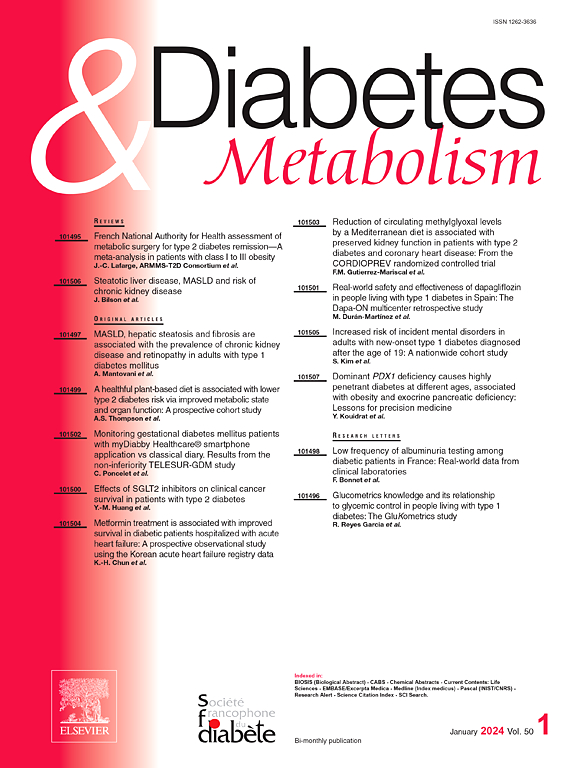Glucagon-like peptide 1 receptor agonists and renal outcomes in kidney transplant recipients with diabetes mellitus
IF 4.7
2区 医学
Q1 ENDOCRINOLOGY & METABOLISM
引用次数: 0
Abstract
Aims
Glucagon-like peptide-1 receptor agonists (GLP1-RAs) show reno-protective effects in type 2 diabetes. Limited data is available on their use in post-transplant diabetes mellitus. We aimed to explore the effect of GLP1-RAs on renal outcomes in diabetic kidney transplant recipients (KTR).
Methods
We conducted a cohort retrospective study on adult KTR with diabetes mellitus. KTR treated with GLP1-RAs were matched with non-users. The primary outcome was the first occurrence of graft rejection, start of dialysis, re-transplantation or all-cause mortality. Other outcomes included a composite of the first occurrence of a genitourinary infection or all-cause mortality, and all-cause mortality. Metabolic effects of GLP1-RA treatment and risk for biliopancreatic adverse events were also explored.
Results
We included 272 patients (69 % males, average age 58.3 ± 11.0 years) with a 3.1-year median follow-up. The use of GLP1-RAs lowered the incidence of the composite renal outcome after adjustment for independent risk factors (114 versus 68 events per 1000-patient years in controls versus GLP1-RA users, HR 0.489, 95 % CI 0.271–0.883). GLP-RA users had improved glycemic control, lipid profile and a decrease in body mass index. The treatment was safe without increased genitourinary infections or biliopancreatic events.
Conclusion
The use of GLP1-RAs decreased the risk of a composite outcome of renal dysfunction and mortality, improved metabolic control and showed safety of use in a large cohort of diabetic KTR, suggesting reno-protective effects in this high-risk population. Prospective data is further needed in KTR who are excluded from large RCTs.
胰高血糖素样肽1受体激动剂与糖尿病肾移植受者的肾脏预后。
目的:胰高血糖素样肽-1受体激动剂(GLP1-RAs)在2型糖尿病中显示肾保护作用。它们在移植后糖尿病中的应用数据有限。我们旨在探讨GLP1-RAs对糖尿病肾移植受者(KTR)肾脏预后的影响。方法:对合并糖尿病的成人KTR患者进行队列回顾性研究。用GLP1-RAs治疗的KTR与非GLP1-RAs治疗的KTR配对。主要结局是首次发生移植排斥反应、开始透析、再次移植或全因死亡率。其他结果包括首次发生泌尿生殖系统感染或全因死亡率,以及全因死亡率。GLP1-RA治疗的代谢影响和胆管不良事件的风险也进行了探讨。结果:我们纳入了272例患者(69%为男性,平均年龄58.3±11.0岁),中位随访期为3.1年。在调整独立危险因素后,GLP1-RAs的使用降低了复合肾结局的发生率(对照组与GLP1-RA使用者每1000例患者年发生68例事件,HR 0.489, 95% CI 0.271-0.883)。GLP-RA使用者改善了血糖控制,血脂和身体质量指数下降。治疗是安全的,没有增加泌尿生殖系统感染或胆胰事件。结论:GLP1-RAs的使用降低了肾功能障碍和死亡率的复合结局的风险,改善了代谢控制,并且在糖尿病KTR的大型队列中显示出使用的安全性,表明在这一高危人群中具有肾保护作用。被排除在大型随机对照试验之外的KTR患者需要进一步的前瞻性数据。
本文章由计算机程序翻译,如有差异,请以英文原文为准。
求助全文
约1分钟内获得全文
求助全文
来源期刊

Diabetes & metabolism
医学-内分泌学与代谢
CiteScore
12.00
自引率
4.20%
发文量
86
审稿时长
13 days
期刊介绍:
A high quality scientific journal with an international readership
Official publication of the SFD, Diabetes & Metabolism, publishes high-quality papers by leading teams, forming a close link between hospital and research units. Diabetes & Metabolism is published in English language and is indexed in all major databases with its impact factor constantly progressing.
Diabetes & Metabolism contains original articles, short reports and comprehensive reviews.
 求助内容:
求助内容: 应助结果提醒方式:
应助结果提醒方式:


